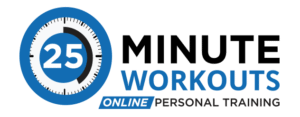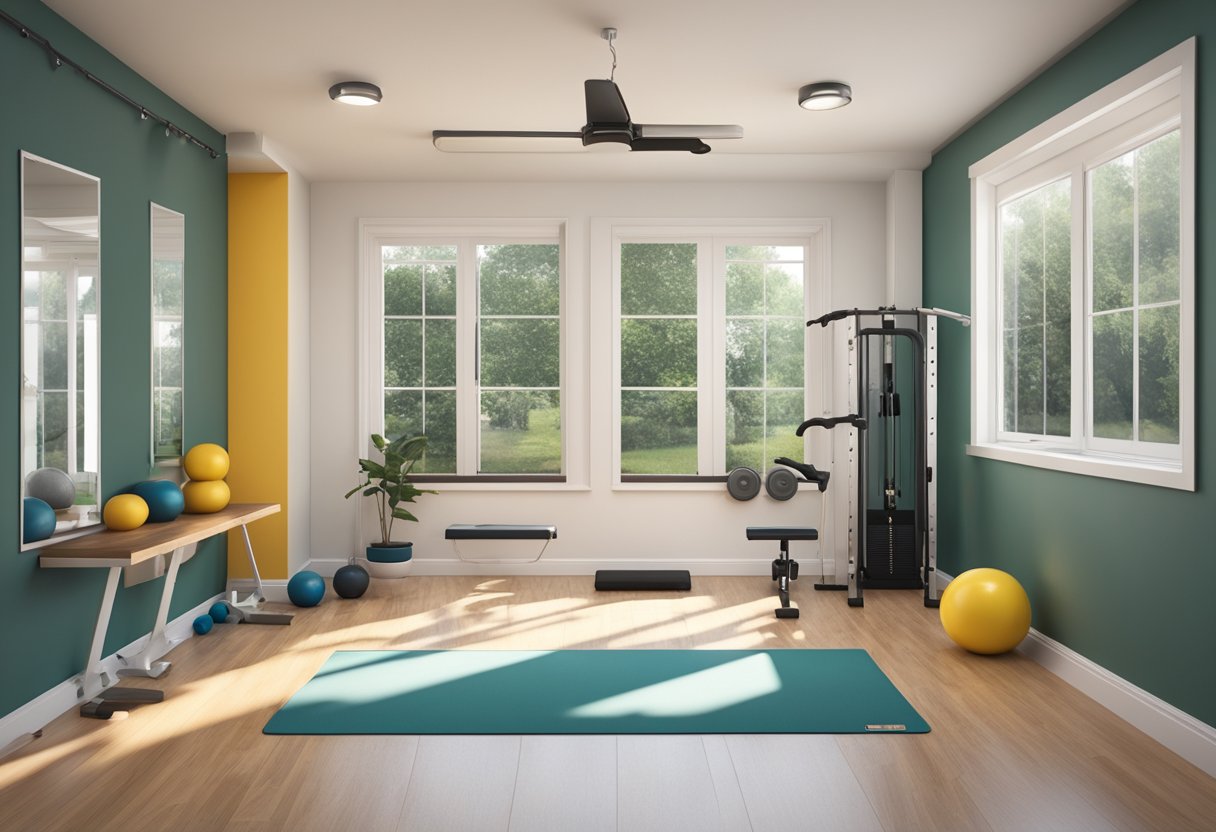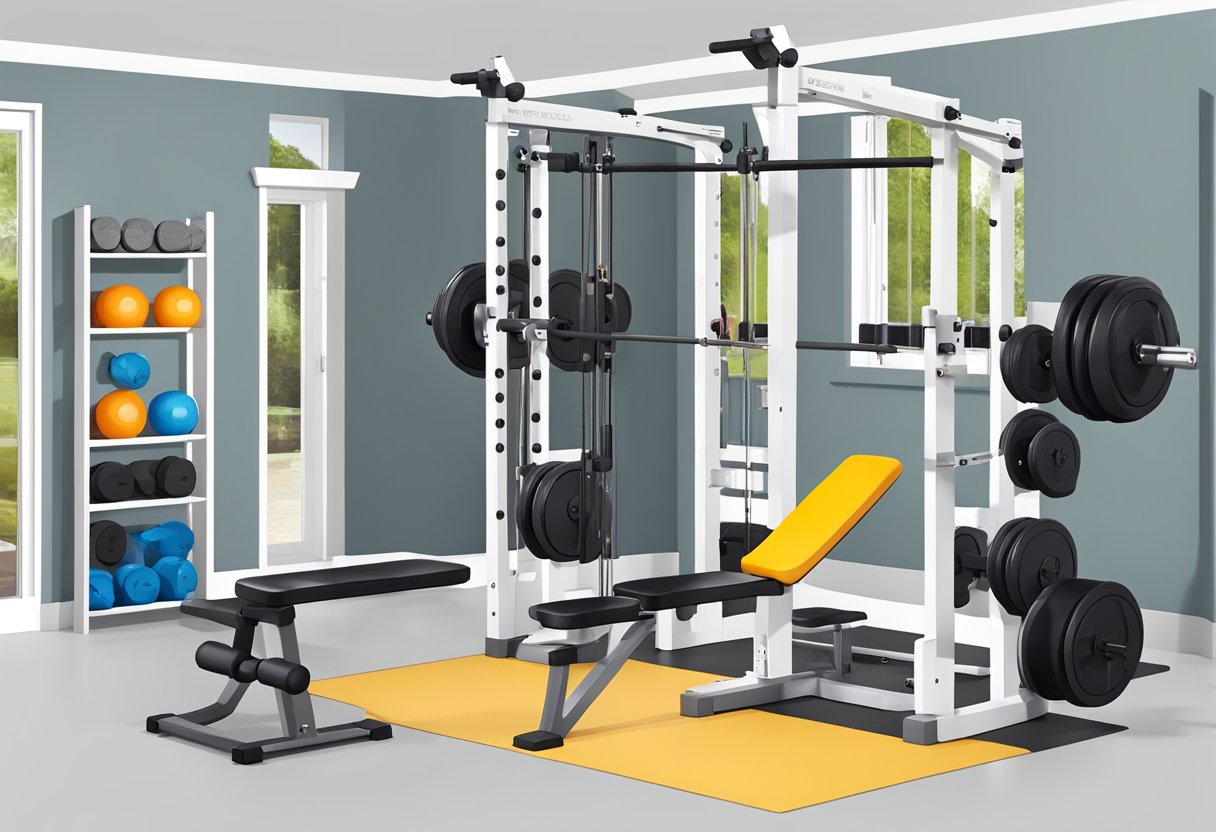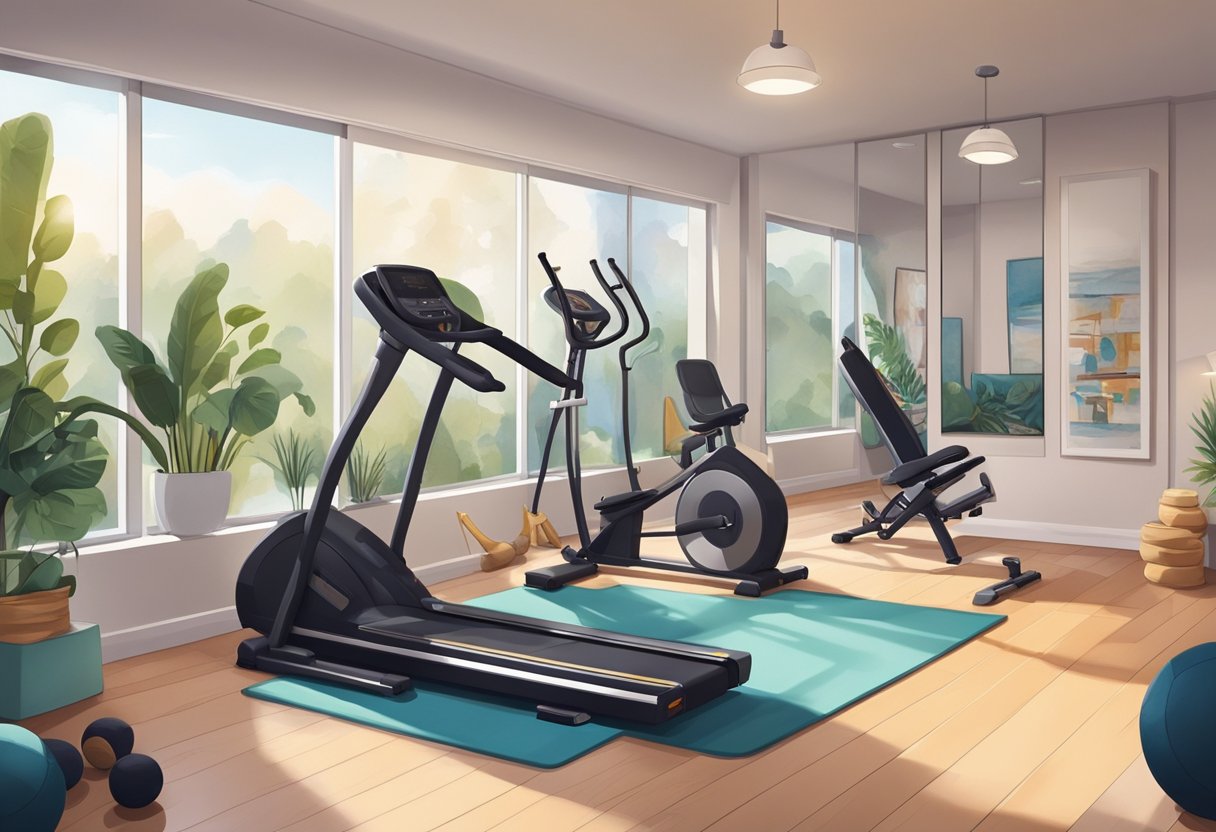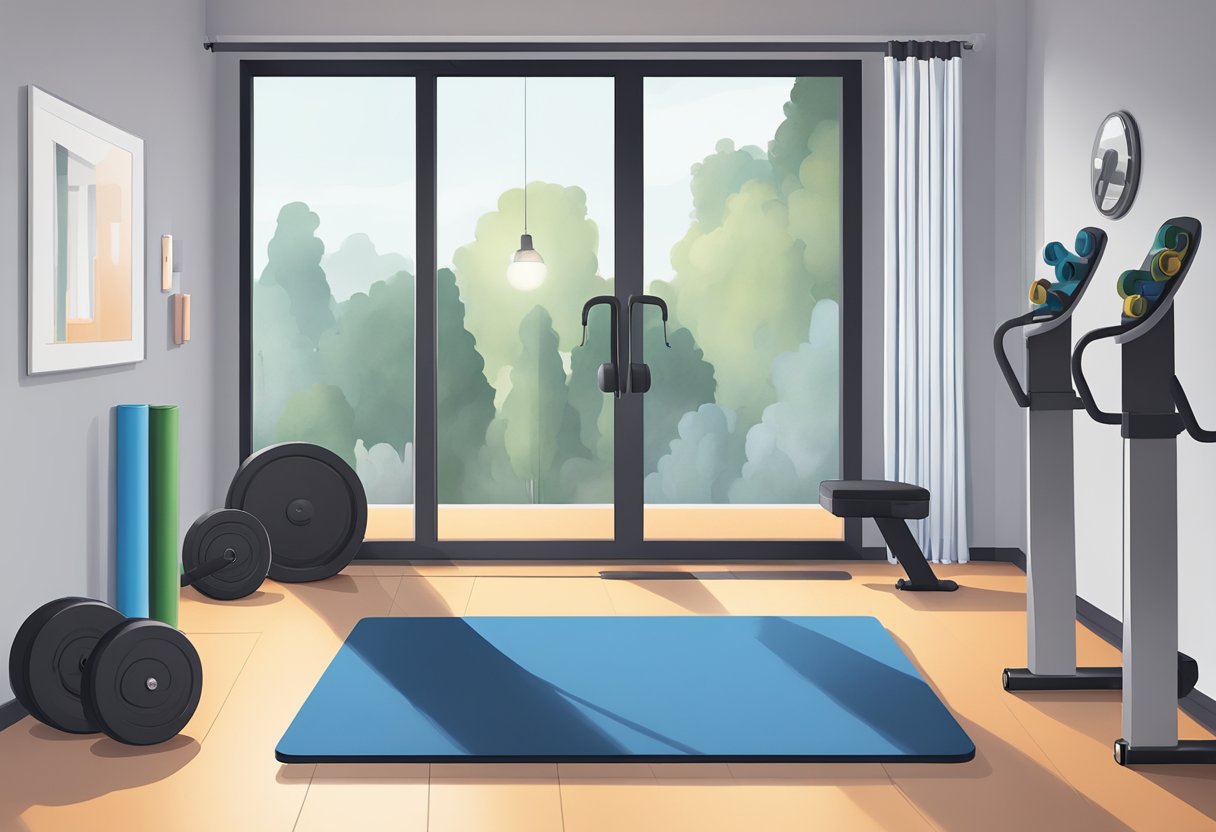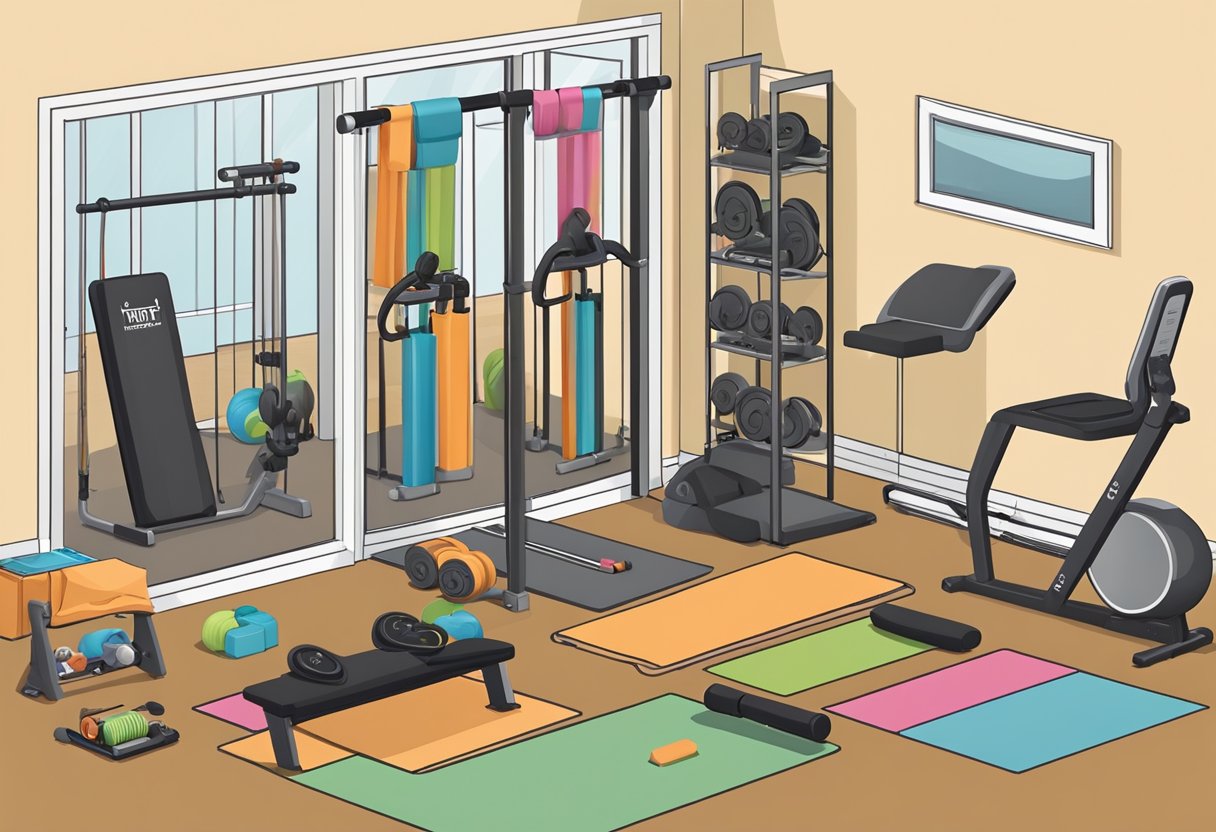Creating your perfect home gym setup in a small space might seem challenging, but with careful planning and smart choices, it’s entirely achievable.
The key is to prioritize versatile equipment and efficient use of space.
For instance, a folding squat rack can save floor space, allowing for a compact yet functional workout area.

To start, consider integrating multifunctional equipment that can cover various aspects of your fitness routine.
Popular Posts
- Massage Gun vs. Foam Roller: Which Recovery Tool Reigns Supreme?
- 27 Best Calisthenics Exercises for Full-Body Strength and Fitness
- 10 HIIT Workouts for Busy Professionals: Max Fitness, Min Time
- Good Posture Working from Home: Optimize Your Workspace to Prevent Discomfort and Health Issues
- The Best Crossfit Exercises for Full-Body Conditioning
A basic bench, for example, can serve both as storage and a prop for multiple exercises, enhancing your training flexibility.
In addition, think about utilizing vertical space with wall-mounted storage solutions for free weights and smaller accessories, as suggested by various home gym layouts.
Creating a workout area that aligns with your fitness goals involves a blend of creativity and practicality.
Whether it’s a corner of your loft or a section of your garage, arranging your equipment thoughtfully ensures that every inch of space contributes to your fitness journey.
Assessing Your Space for a Home Gym

When planning a home gym in a small space, you’ll need to evaluate the dimensions, make use of vertical space, and consider room divider strategies. This will ensure you get the most out of your available area without it feeling cramped.
Evaluating Room Dimensions
Start by measuring the dimensions of your desired gym area.
Small spaces, such as 100-500 square feet, can still accommodate a variety of exercises.
Make a list of essential equipment and check their spatial requirements.
For example, a bench might need 16-20 square feet, while a treadmill typically requires 30 square feet plus clearance.
Map out your floor plan to see where each piece of equipment will fit.
Consider creating zones for different activities, such as cardio, strength training, and stretching.
Using a scaled drawing or an online room planner tool can help visualize your setup before moving any equipment.
Optimizing Vertical Space
Vertical space can play a crucial role in maximizing efficiency.
Use wall-mounted storage solutions like hooks, shelves, and racks to keep your equipment organized and off the floor.
This allows you to store yoga mats, resistance bands, and smaller weights neatly.
You might also install a pull-up bar or wall-mounted strength training systems to utilize vertical space for workouts.
When choosing equipment, consider foldable or compact items that can be easily stored when not in use.
A folding bench, for example, can save space and provide flexibility in your layout.
Room Divider Strategies
Using room dividers can help separate your workout area from other parts of your home, creating a dedicated exercise space.
Consider portable room dividers, curtains, or even bookcases to partition the area.
This not only enhances privacy but also helps you maintain focus during your workouts.
Incorporating multi-functional furniture like a storage bench can serve as both a seating area and a place to keep your equipment.
Choose dividers that complement your decor to make the space more inviting.
Selecting the Right Equipment
When designing a home gym for small spaces, prioritizing multifunctional and space-efficient equipment will maximize your workout area. Embrace tools that offer various exercises without consuming too much room, ensuring every piece serves a purpose.
Essential Equipment for Small Spaces
Selecting essential equipment tailored for compact areas is crucial.
Adjustable dumbbells are a smart choice, providing a range of weights without needing multiple sets.
These dumbbells adjust from five to fifty pounds, catering to different workout needs.
Kettlebells offer versatility and can be used for strength training and cardio exercises.
A workout mat provides a comfortable surface for exercises and can be easily rolled up and stored.
Resistance bands are another essential tool. They are compact, lightweight, and provide various resistance levels to enhance strength training routines.
Focused on Functional Gym Pieces
Functional gym pieces save space while delivering effective workouts.
A versatile piece like a folding bench not only supports various exercises but can be easily stored when not in use.
Including a jump rope in your home gym is beneficial for cardio workouts.
It’s compact, portable, and highly engaging for high-intensity training.
A medicine ball can be used for core exercises, strength training, and even aerobic conditioning.
It doesn’t take up much space and can add significant value to your routines.
Exercise sliders enable low-impact workouts for your core, legs, and arms.
These small discs glide smoothly on various surfaces, adding versatility to your home gym setup.
Importance of Adjustable Equipment
Adjustable equipment adapts to different workout needs and saves space.
Adjustable benches can be modified for various angles, enhancing the range of exercises you can perform.
Including adjustable kettlebells is another effective strategy. These kettlebells allow you to change the weight, reducing the need for multiple pieces.
Adjustable pull-up bars can be mounted at different heights or doorframes, accommodating various exercises without permanent installation.
Additionally, consider modular storage solutions that can be reconfigured to hold adjustable weights and accessories, keeping the area organized and accessible.
Maximizing Gym Storage Solutions
Efficient storage solutions are crucial for making the most of limited space in your home gym. Consider using innovative storage racks, wall-mounted systems, and multipurpose furniture to keep your equipment organized and accessible.
Innovative Storage Racks
Storage racks can significantly enhance your gym’s organization.
Look into versatile racks that can accommodate various types of equipment such as dumbbells, kettlebells, and resistance bands.
Adjustable shelving racks are particularly useful as they allow you to modify the layout as your equipment needs change.
Another option is tiered racks which make it easy to see and access all your weights without occupying much floor space.
Vertical storage racks work well for items like foam rollers and yoga mats.
Modularity is key, so aim for racks that can be expanded or reconfigured.
Using compact, sturdy designs will maximize your storage capacity and keep your gym clutter-free.
Wall-mounted Systems
Wall-mounted storage is excellent for freeing up floor space.
Use sturdy hooks or pegboards to hang items like resistance bands, jump ropes, and suspension trainers.
Shelving units mounted on walls can hold smaller items such as water bottles, towels, and workout gloves, keeping them within easy reach but out of the way.
Installing a wall-mounted rack for your bars and plates can also save space.
Opt for heavy-duty options to ensure they can handle the weight.
Additionally, a ceiling-mounted punching bag can provide an excellent workout without using valuable floor space.
Utilizing Multipurpose Furniture
Furniture that serves dual purposes can greatly enhance your home gym’s flexibility.
An entry bench with built-in storage compartments allows you to store smaller equipment like shoes, weights, and bands while also providing a spot for exercises like step-ups.
Choose pieces that are both sturdy and versatile.
Folding furniture, such as collapsible plyo boxes, can be used for exercises and then stored flat to save space.
Look for furniture that can be easily moved or reconfigured to fit different workout requirements.
These multipurpose solutions not only save space but also make your gym more dynamic and adaptable to various training needs.
Designing for Comfort and Aesthetics
Creating a home gym that balances functionality with visual appeal ensures you and your household will actually enjoy using the space. You can achieve this by thoughtfully selecting your color palette, incorporating natural elements, and choosing the right flooring.
Selecting a Color Palette
Color palette plays a pivotal role in setting the mood of your gym.
Opt for calming, neutral colors like gray, beige, or soft white to create a serene environment.
If you prefer something bolder, colors like navy blue or deep green can make the space feel invigorating.
You might consider using calming hues like blues and greens for a meditation or yoga area. These colors promote relaxation and focus.
In addition, accent walls with wallpaper featuring subtle patterns can add a touch of elegance and personality to the room.
Incorporating Natural Elements
Incorporating natural elements into your gym can elevate both its aesthetic and comfort.
Using materials like wood and stone can lend a warm and inviting feel to the room.
For example, wooden shelves or a stone accent wall can make the space feel more grounded and stylish.
Plants are another excellent addition, as they improve air quality and bring a touch of nature indoors.
Place potted plants in corners or hanging planters along the walls to add greenery without taking up floor space.
This not only enhances visual appeal but also creates a more refreshing and calming environment.
Choosing the Right Flooring
Selecting the appropriate flooring is essential for both comfort and practicality.
Rubber flooring is an excellent choice for high-impact exercises as it provides cushioning and reduces the risk of injury. It’s also durable and easy to clean.
If aesthetics are a priority, consider using vinyl plank flooring, which mimics the look of wood but is more resilient and moisture-resistant.
For yoga or pilates areas, cork flooring can offer a comfortable and eco-friendly option. It is soft underfoot and has natural anti-microbial properties.
Creating a Workout Environment
Designing a small home gym involves optimizing your space for various exercises. Focus on including areas for cardio, strength training, and flexibility to enhance your workouts.
Cardio Session Considerations
Cardio exercises are crucial for heart health and endurance. A compact treadmill can fit against a wall and provide a convenient way to run or walk.
HIIT workouts can be done in small spaces using your body weight, like jump squats and burpees.
Consider allocating around 30 square feet for a treadmill, plus extra space for safety.
For a more dynamic cardio setup, invest in foldable equipment, such as an exercise bike or a compact elliptical machine.
Utilize wall storage for accessories like resistance bands or jump ropes to keep your space organized.
Proper ventilation will also help maintain a comfortable environment during intense workouts.
Strength Training Essentials
Strength training in a small space requires selecting multi-functional gym equipment. A weight bench is versatile for exercises like bench presses and step-ups.
Pair it with dumbbells or kettlebells which can be stored easily on a rack to save space.
Opt for a foldable or wall-mounted bench to maximize floor space when not in use.
A folding squat rack is another efficient choice, offering stability for heavy lifts and storing compactly against the wall.
Add a lifting platform, if space allows, to protect your floors and provide a stable surface for deadlifts and other heavy exercises.
Use vertical storage to keep plates and bars easily accessible.
Flexibility and Recovery Zone
Creating a designated area for flexibility and recovery can prevent injury and improve your overall fitness. Set up a yoga mat where you can do stretching, foam rolling, and bodyweight exercises.
Space-saving ladder shelves can hold items like yoga blocks, straps, and towels.
A corkboard or wall hooks are ideal for hanging equipment like resistance bands and suspension trainers, keeping them off the floor.
Incorporate a small coffee table to serve as a convenient spot for weights or foam rollers.
Ensure this area is flexible enough to transition between stretching and cool-down exercises after your workouts.
Frequently Asked Questions
To make the most out of a limited space for your home gym, considering layout, essential equipment, budget tips, and creative ideas is crucial. Having the right knowledge allows you to create an efficient workout area regardless of size.
How can one maximize space in a small home gym layout?
Utilize vertical space with wall-mounted racks or shelves.
Choose multi-functional equipment like adjustable dumbbells or resistance bands.
Arrange gear for easy access and ensure a smooth workout flow.
Strategic use of mirrors can make the area appear larger and help you maintain proper form.
What are essential pieces of equipment for a compact home gym?
Opt for smaller, versatile items such as adjustable dumbbells, resistance bands, and a foldable bench.
Compact cardio machines like a jump rope or foldable treadmill are effective.
Consider investing in multi-functional equipment that replaces several single-purpose devices, saving both space and money.
How can a small home gym be designed on a budget?
Look for deals on used or refurbished equipment.
Use household items like sturdy chairs for support exercises.
DIY solutions like homemade weight racks or storage boxes can help organize your space.
Prioritize the basics first and gradually add more equipment as your budget allows.
What are some creative decoration ideas for a small home gym area?
Incorporate mirrors to create a sense of space and aid in workout routines.
Brighten the area with natural and artificial lighting.
Add a corkboard for organizing fitness accessories like straps and yoga mats or use ladder shelves for storing towels and small equipment.
A small rug can define the workout zone.
Can effective workouts be achieved in a small-sized basement gym?
Yes, effective workouts are possible in any space size.
Focus on bodyweight exercises like push-ups, squats, and planks, which require minimal equipment.
Use resistance bands or adjustable weights for strength training.
Tailor your workouts to utilize the space you have efficiently.
How to choose gym equipment that fits in limited spaces like a shed or small room?
Select equipment with a small footprint or that can be easily stored away.
Consider items like foldable benches, stackable weights, and compact cardio machines.
Multi-functional gear that can be quickly adjusted or repurposed for different exercises is also ideal for maximizing limited space.
